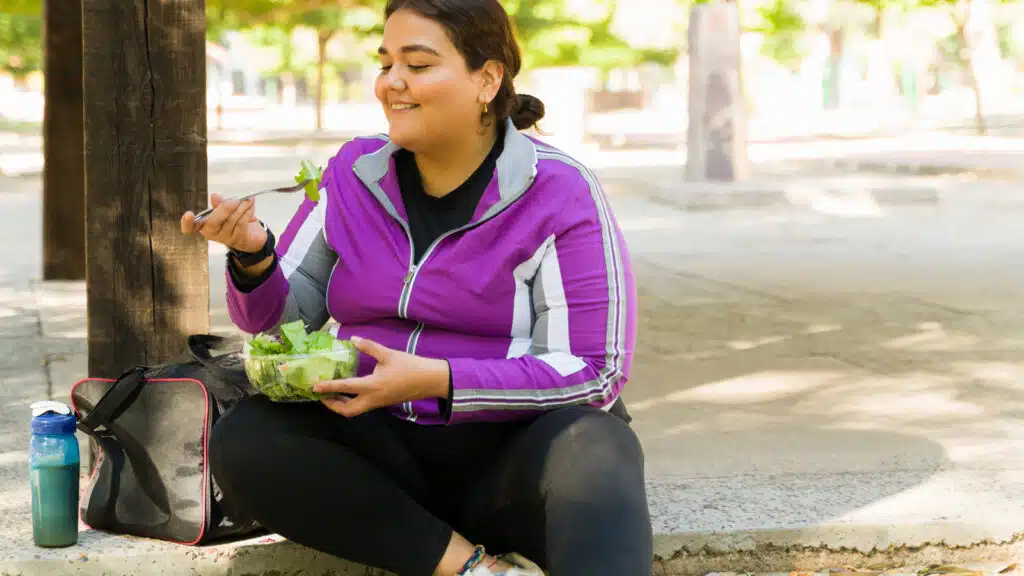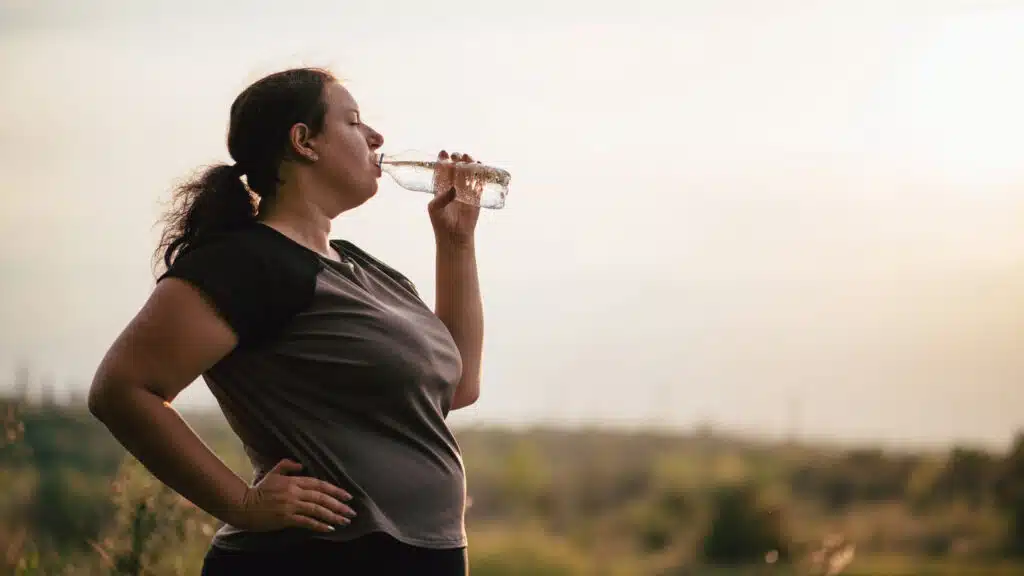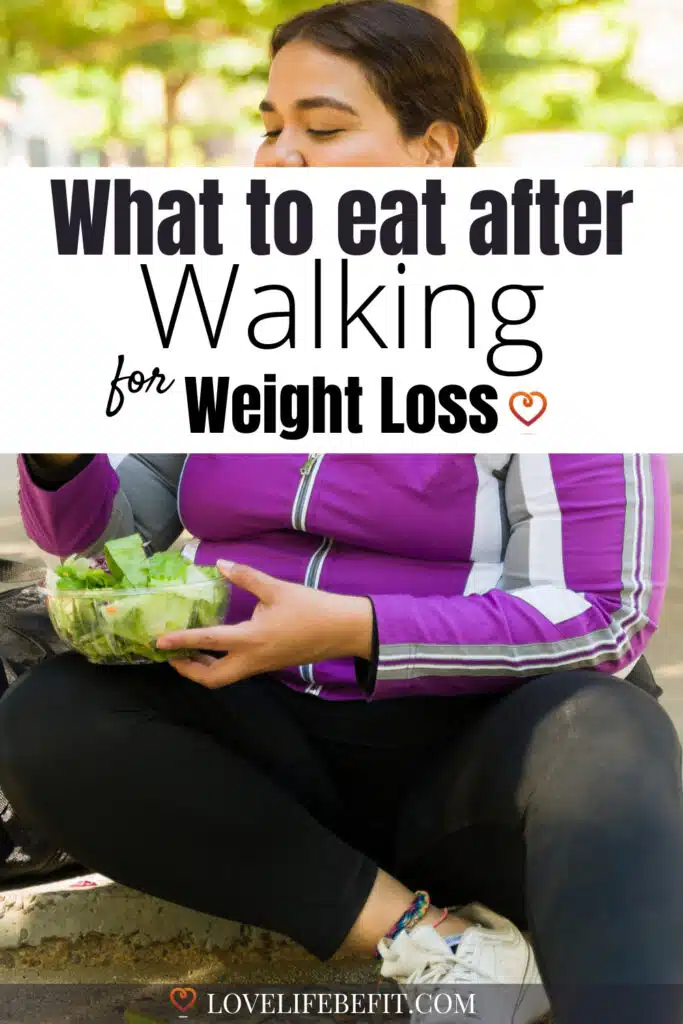Looking to drop a few pounds? Then walking for weight loss is a great way to start. But it can be tough to know what to eat for a post-workout meal if you’re trying to lose weight.
Walking is an aerobic exercise that’s excellent for burning calories, and most of those calories will come from body fat.
But after your walk, how do you replace the glycogen stores and muscle proteins you need for your next workout – without blowing your weight loss gains from walking?
Read on for some of the best tips for what to eat when you’re walking to lose weight.

Should You Walk On An Empty Stomach?
Normally when you go for a walk, some of the energy used will come from glucose in your bloodstream and glycogen stores in your liver and muscles. The rest will come from burning fat.
The idea behind walking on an empty stomach, (walking fasted first thing in the morning), is your glycogen stores and blood glucose levels are depleted and your body is forced to burn fat instead.
That sounds brilliant when you’re trying to lose weight. Burn calories from fat!
Unfortunately, the human body isn’t that simple.
When you eat after your walk, your body will top up its depleted glycogen stores. Excess carbohydrates are stored as fat. The more your glycogen stores are depleted – the more carbohydrates it takes to top them up.
Sounds good!
But, unless you’re a trained athlete, it’s tough walking fasted. It’s hard to maintain a brisk pace and keep going for longer exercise sessions.
Instead of fat burning, you could end up crashing and burning – losing any advantages of walking on an empty stomach. The result – not walking very far or burning many calories.
Exercising fasted may help with weight loss but there’s very little scientific evidence. For most people, it’s better to eat a light pre-workout meal 1-2 hours before your walk to make sure you can complete your exercise session.
Related post: Does Walking Burn Belly Fat?
Post-Workout Meal After Walking For Weight Loss
After your walk, it’s important to refuel your body with the right kind of food. A post-workout meal or small snack helps to replenish glycogen stores and rebuild muscles broken down or damaged during your workout.
Carbohydrates
Eating carbohydrates tops up the glycogen levels in your liver and muscles, giving you energy for your daily activities and your next exercise session.
Protein
Consuming protein provides your body with the essential amino acids it needs to repair and rebuild your muscle protein.
Strength training
Your muscles are continually breaking down and rebuilding – a process known as muscle protein synthesis. Your muscles grow when muscle protein synthesis exceeds muscle protein breakdown.
Strength training or just building stronger legs for walking doesn’t work without consuming adequate amounts of protein.
Amount of protein
There’s a big difference between the amount of protein you need to maintain lean muscle mass and eating protein to build big muscles.
When athletes eat protein to build muscle mass, their intake is up to 2 grams of protein per kg of body weight.
But for most people walking for weight loss, 1 g per kg of body weight is plenty. Eat too much and the excess protein is converted to body fat.
Carb-to-protein ratio
The ideal ratio of carbs to protein after a workout is 3:1. That means for every 3 grams of carbs, you should eat 1 gram of protein.
Try and eat a snack within 30 to 45 minutes of completing your walk, or better still, time your walk so it’s just before your main meal. It’s an effective way to provide your body with the nutrients it needs without increasing your daily calorie intake.

Improving Your Diet With Small Changes
The best way to get results walking for weight loss is by combining walking with a balanced diet full of healthy nutritious foods.
But don’t change everything overnight – it can quickly overwhelm you and be difficult to maintain.
Instead, making small changes to your diet can have a big impact on your overall health. Rather than trying to completely change your diet, make a few small changes and watch the health benefits add up.
For example, switching to whole grains instead of processed grains will increase the amount of fiber you eat, and help regulate your blood sugar levels. It could just be a simple change such as eating wholemeal instead of white bread.
The complex carbohydrates in whole grains aid weight loss by making you feel fuller for longer.
Related post: Is Diet More Important Than Exercise?
Avoid Processed Foods And Sugary Drinks
Addicted to sugar or just love the taste of processed foods high in saturated fat?
We all know these foods are bad for us but fast food habits are hard to shift. If you’re a sugar addict, it may take a major shake-up to change your relationship with all things sweet. Quitting sugar for a month will help to reset your taste buds and do wonders for your waistline.
It can be hard to resist the pull of the fast-food outlet. Start by limiting your visits to one a week – once a month is even better, and make some effort to cook tasty food at home to limit fat intake.
Try and plan your menus around the right foods – lean protein, whole grains, vegetables, and small amounts of healthy fat such as olive oil, avocado or nuts. Eat fresh fruit as a delicious treat. Use spices to liven up your home cooking!
Related post: Vegan Meal Prep For Weight Loss
Eat The Rainbow
Too many of us mainly eat beige-colored food – potatoes, fries, breakfast cereal, bread… lots of beige food low in nutrients.
Eating the rainbow is a conscious effort to eat the minerals and vitamins your body needs. The color differences in plants are linked to specific nutrients.
So for example, blue and purple berries such as blueberries are packed with antioxidants. Green, leafy cruciferous vegetables reduce the risk of cancer and heart disease. Orange and yellow vegetables are loaded with vitamin A and vitamin C.
A lack of nutrients can make you more hungry or affect your metabolism. It’s possible to eat too many calories but still be malnourished.
Aim to eat as many different colors of fruits and vegetables every day as you can – not just one or two types! That way, you’ll enjoy a wide variety of nutrients and flavors.

Hydration
Staying hydrated is important for anyone, but it’s especially crucial if you’re trying to lose weight. When you walk, your body uses up a lot of water, so it’s important to drink before you exercise – especially when it’s hot!
Drink a large glass an hour before you exercise so it’s already in your system when you start your walk – and you’ll avoid taking pee stops!
During long walks, keep a water bottle with you and take small sips regularly. Always drink to thirst to avoid the dangers of overdrinking.
After your walk, drink a large glass of water to replace the fluids you’ve lost.
Staying hydrated can also help you to avoid overeating. Often, people confuse thirst with hunger, leading them to eat when they really just need a drink.
Drink a glass of water before meals – you’ll be less likely to overeat.
Related post: How To Start A Walking Program For Beginners
Estimating Calorie Needs
Calorie counting is best avoided if you have a history of eating disorders but for most people, it’s good to have a rough idea of your daily calorie needs.
Otherwise, if you eat unlimited amounts of food, weight gain is possible even following a walking for weight loss plan.
You can find your daily calorie needs using this daily calories burned calculator.
I like to set the calculator to a sedentary lifestyle and use this walking calculator to estimate my calorie burn from walking.
Most people overeat
Keeping a food diary for a week or two will give you a good idea of your typical calorie intake and help you check if you’re building the calorie deficit you need for weight loss.
Don’t aim for a big deficit or you’ll push your body into starvation mode. Just aim to eat fewer calories and walk a little more. Most people find a deficit of 500 calories a day is about right and can lead to one pound of weight loss a week.
That may not seem much, but one pound a week adds up to ten pounds in 10 weeks of permanent weight loss!
There’s no need to be fixated on calorie counting – just keep making small improvements to your diet and increase your physical activity by walking regularly to get results.
Burn more calories
Increase the exercise intensity, walk up hills, walk to work and make the lifestyle changes that will help you hit your weight loss goals and maintain a healthy weight.
Aim to increase your daily energy expenditure with a regular walking routine.
Related post: How To Lose Weight walking 2 Miles A Day
Low-Carb Diets
Low-carb diets are extremely popular and can be good for short-term results. Cutting back on carbs can help when you’re walking for weight loss – but cut carbohydrates too much and you’ll struggle with aerobic exercise.
Carbs provide energy for your long walks, intense workouts, and power walking. In theory, if you eat fewer carbs you could burn more body fat when you walk. In practice, it takes training to burn fat efficiently. Most people will just feel terrible when they run their glycogen stores too low – just like hitting the wall in a marathon!
By all means, avoid that second serving of potatoes or pasta, but you’ll still need some carbs to complete your walking workout and hit your fitness goals.

Enjoy your post-walk meal
Walking can make you very hungry. Enjoy it! Eating is so much better when you’ve worked up an appetite!
Stop when you’re full and don’t overeat. It’s important to eat after a workout so don’t feel guilty – just enjoy eating some good food.
Here are some ideas for a post workout snack or light meal:
- Greek yogurt with berries
- Peanut butter on wholemeal toast
- Bean chili and rice
- Hummus and pita
- Grilled fish with brown rice and steamed vegetables
- Chickpeas, salad, and baked sweet potato
Remember that walking is so much more than just burning calories – it’s about getting fit, enjoying the outdoors, improving your mental health, and making good choices about your diet.
